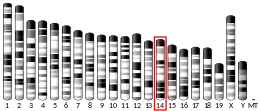ADAM7
Disintegrin and metalloproteinase domain-containing protein 7 is a protein that in humans is encoded by the ADAM7 gene.[5] ADAM7 is an 85-kDa enzyme that is a member of the transmembrane ADAM (A Disintegrin and Metalloprotease) protein family. Members of this family are membrane-anchored proteins structurally related to snake venom disintegrins, and have been implicated in a variety of biological processes involving cell-cell and cell-matrix interactions, including fertilization, muscle development, and neurogenesis. ADAM7 is important for the maturation of sperm cells in mammals. ADAM7 is also denoted as: ADAM_7, ADAM-7, EAPI, GP-83, and GP83.
| ADAM7 | |||||||||||||||||||||||||||||||||||||||||||||||||||
|---|---|---|---|---|---|---|---|---|---|---|---|---|---|---|---|---|---|---|---|---|---|---|---|---|---|---|---|---|---|---|---|---|---|---|---|---|---|---|---|---|---|---|---|---|---|---|---|---|---|---|---|
| Identifiers | |||||||||||||||||||||||||||||||||||||||||||||||||||
| Aliases | ADAM7, ADAM 7, ADAM-7, EAPI, GP-83, GP83, ADAM metallopeptidase domain 7 | ||||||||||||||||||||||||||||||||||||||||||||||||||
| External IDs | OMIM: 607310 MGI: 107247 HomoloGene: 2830 GeneCards: ADAM7 | ||||||||||||||||||||||||||||||||||||||||||||||||||
| |||||||||||||||||||||||||||||||||||||||||||||||||||
| |||||||||||||||||||||||||||||||||||||||||||||||||||
| |||||||||||||||||||||||||||||||||||||||||||||||||||
| |||||||||||||||||||||||||||||||||||||||||||||||||||
| |||||||||||||||||||||||||||||||||||||||||||||||||||
| Wikidata | |||||||||||||||||||||||||||||||||||||||||||||||||||
| |||||||||||||||||||||||||||||||||||||||||||||||||||
Function
The functions of ADAM7 directly relate to sperm maturation and fertilization. Sperm are immobile until traversing the epididymis, in which the sperm interact with many proteins secreted by epithelial cells of the epididymis.[6] Lacking protease activity, ADAM7 may play roles in protein-protein interactions and cell adhesion processes including sperm-egg fusion. ADAM7 is secreted by epididymis cells and transferred to the maturing sperm's surface. As determined through mouse gene knock-out studies, the amount of ADAM7 secreted is directly linked to ADAM2 and ADAM3 protein levels.[7] Complex formation between ADAM7, Calnexin, Hspa5, and Itm2b have been shown to act as a molecular chaperone after ADAM7 is incorporated into the membrane of sperm cells. Furthermore, complex formation with Itm2b is increased during sperm capacitation leading to a conformation change in ADAM7.[7] As such, the ADAM7 protein plays an important function involved in sperm capacitation, although this function is not entirely understood.
Mechanism of secretion and membrane transfer
ADAM7 is synthesized in epididymis cells and transferred to the membrane of immature sperm cells as they traverse the epididymis during sperm maturation. Epithelial cells of the epididymis incorporate ADAM7 into their membrane normally like other integral membrane protein.[6] Portions of the membrane are secreted as exosome vesicles. Secretion in this manner is an apocrine secretion in which apical blebs containing a portion of the epididymis cell are released from the cell. The apical blebs then encounter the immature sperm cell membrane within the convoluted tubules of the epididymis. The apical bleb and immature sperm cell membrane then fuse, ultimately incorporating ADAM7 into the sperm cell membrane.[8][9]
Physical characteristics
Human ADAM7 contains a sequence of 756 amino acids.[10] Numerous mammalian orthologs are currently known.[11] The largest portion of ADAM7 resides in the extracellular space. A short helical transmembrane sequence anchors the sequence while a short cytoplasmic sequence exists. This is consistent and expected as the protein has a secretory function.[12]
Localization
ADAM7 expression is localized in mammalian epididymis cells. Expression of ADAM7 is higher in the head (Caput) of the epididymis and decreases in cells towards the distal epididymis.[13] ADAM7 is also present in mature sperm cell membranes of mice.[14] Thus, ADAM7 is synthesized in the epididymis and transferred to the maturing sperm cell membrane. mRNA transcripts are highly expressed in testes leydig cells as well.[15]
Model Organisms
Due to the large mammalian homology, ADAM7 is primarily studied in Mus Musculus.
References
- GRCh38: Ensembl release 89: ENSG00000069206 - Ensembl, May 2017
- GRCm38: Ensembl release 89: ENSMUSG00000022056 - Ensembl, May 2017
- "Human PubMed Reference:". National Center for Biotechnology Information, U.S. National Library of Medicine.
- "Mouse PubMed Reference:". National Center for Biotechnology Information, U.S. National Library of Medicine.
- "Entrez Gene: ADAM metallopeptidase domain 7".
- Oh, Jeong Su; Han, Cecil; Cho, Chunghee (2009). "ADAM7 Is Associated with Epididymosomes and Integrated into Sperm Plasma Membrane". Molecules and Cells. 28 (5): 441–446. doi:10.1007/s10059-009-0140-x. PMID 19855936. S2CID 591146.
- Cho C (Oct 2012). "Testicular and epididymal ADAMs: expression and function during fertilization". Nature Reviews. Urology. 9 (10): 550–560. doi:10.1038/nrurol.2012.167. PMID 22926424. S2CID 23223954.
- Hermo, L; Jacks, D (2002). "Nature's ingenuity: bypassing the classical secretory route via apocrine secretion". Mol. Reprod. Dev. 63 (3): 394–410. doi:10.1002/mrd.90023. PMID 12237956. S2CID 22251485.
- Sullivan, R; Saez, F; Girouard, J; Frenette, G (2005). "Role of exosomes in sperm maturation during the transit along the male reproductive tract". Blood Cells Mol. Dis. 35 (1): 1–10. doi:10.1016/j.bcmd.2005.03.005. PMID 15893944.
- "Homo sapiens (human): 8756". www.genome.jp. Retrieved 9 March 2015.
- "ORTHOLOGY: K16071". www.genome.jp. Retrieved 9 March 2015.
- "Disintegrin and Metalloproteinase Domain-containing Protein 7". UniProt. Retrieved 29 April 2015.
- Oh J, Woo JM, Choi E, Kim T, Cho BN, Park ZY, Kim YC, Kim DH, Cho C (Jun 2005). "Molecular, biochemical, and cellular characterization of epididymal ADAMs, ADAM7 and ADAM28". Biochemical and Biophysical Research Communications. 331 (4): 1374–1383. doi:10.1016/j.bbrc.2005.04.067. PMID 15883027.
- Kim T, Oh J, Woo JM, Choi E, Im SH, Yoo YJ, Kim DH, Nishimura H, Cho C (Apr 2006). "Expression and relationship of male reproductive ADAMs in mouse". Biology of Reproduction. 74 (4): 744–750. doi:10.1095/biolreprod.105.048892. PMID 16407499.
- "Adam7 (ADAM metallopeptidase domain 7)". Biogps. Retrieved 12 May 2015.
External links
- The MEROPS online database for peptidases and their inhibitors: M12.956
- Endocrinology Journal
- Gene expression/activity chart via biogps: mRNA Tissue Expression
- Human ADAM7 genome location and ADAM7 gene details page in the UCSC Genome Browser.



